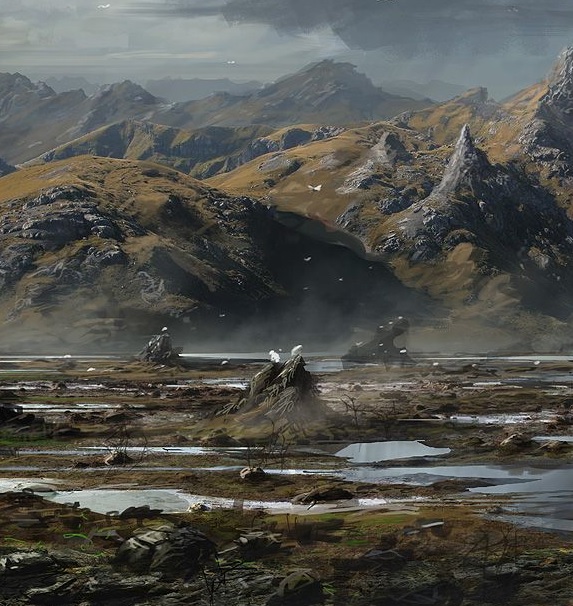Difference between revisions of "Hinterland"
Tao alexis (talk | contribs) |
Tao alexis (talk | contribs) |
||
| (One intermediate revision by the same user not shown) | |||
| Line 1: | Line 1: | ||
[[File:Hinterland.jpg|right|525px|thumb|Not all hinterland is forest.]] | [[File:Hinterland.jpg|right|525px|thumb|Not all hinterland is forest.]] | ||
| − | '''Hinterland''' consists of marginally productive, vast expanses of the countryside, characterised by a variety of topographical features, vegetations and climates. Represented on game maps as "[[Hex | + | '''Hinterland''' consists of marginally productive, vast expanses of the countryside, characterised by a variety of topographical features, vegetations and climates. Represented on game maps as "[[Type-8 Hex|type-8 hexes]]," these lands are considered arable but have not yet been adapted to [[Farmland|cultivation]]. Within such areas there may be the abode of a hunter or a hermit — or possibly a [[Robber's Den|robber's den]] or the camp of an outlaw band of outsider humanoids, evading what constabulary might exist — but no sign of the law, as the land retains a sense of wildness. |
__TOC__ | __TOC__ | ||
This means the hinterland boasts untapped agricultural potential, with nutrient-rich soils and abundant water sources, promising a bountiful harvest once brought under the plough. Thus it makes a prime hunting ground, offering animals such as [[Deer|deer]] and other hooved animals, [[Boar (wild)|boars]], rabbits, and various fowl. There are wild plants, herbs, berries, sources for honey and other natural forage aplenty. Apart from sustenance, there are herbs for traditional remedies and materials for craftwork or building. | This means the hinterland boasts untapped agricultural potential, with nutrient-rich soils and abundant water sources, promising a bountiful harvest once brought under the plough. Thus it makes a prime hunting ground, offering animals such as [[Deer|deer]] and other hooved animals, [[Boar (wild)|boars]], rabbits, and various fowl. There are wild plants, herbs, berries, sources for honey and other natural forage aplenty. Apart from sustenance, there are herbs for traditional remedies and materials for craftwork or building. | ||
| Line 16: | Line 16: | ||
See also,<br> | See also,<br> | ||
| + | [[Bread (symbol)]]<br> | ||
[[Hinterland Generation]]<br> | [[Hinterland Generation]]<br> | ||
[[The Adventure]] | [[The Adventure]] | ||
Latest revision as of 18:15, 3 September 2023
Hinterland consists of marginally productive, vast expanses of the countryside, characterised by a variety of topographical features, vegetations and climates. Represented on game maps as "type-8 hexes," these lands are considered arable but have not yet been adapted to cultivation. Within such areas there may be the abode of a hunter or a hermit — or possibly a robber's den or the camp of an outlaw band of outsider humanoids, evading what constabulary might exist — but no sign of the law, as the land retains a sense of wildness.
This means the hinterland boasts untapped agricultural potential, with nutrient-rich soils and abundant water sources, promising a bountiful harvest once brought under the plough. Thus it makes a prime hunting ground, offering animals such as deer and other hooved animals, boars, rabbits, and various fowl. There are wild plants, herbs, berries, sources for honey and other natural forage aplenty. Apart from sustenance, there are herbs for traditional remedies and materials for craftwork or building.
Proximity to Civilisation
Many hinterland areas are but a few miles from nearby settlements or small holdings, so that venturing into this semi-wild is for some a daily activity. Pathways that may have been trod upon for a dozen generations give way to ponds for fishing, places where a shrine might be placed and other sacred places; some such may be well-hidden. In the meantime, many professions, such as woodcutters or mushroom hunters, come to know these places very well. Some are even protected by druids, who won't wish to see them exploited or even entered upon.
There is great potential for hamlets or freeholders to expand their wealth by investing capital to clear hinterland spaces. A rising population, a need for more wood and other resources or a desire to own one's own land encourages homesteading. Over time, uncultivated hinterlands — characterised for their wild, natural beauty — are reduced to farmland and eventually made urban with time. The expansion of hamlets and freeholders into uncultivated lands was driven by a combination of factors; it serves well to remember that every farm, every village, was once a hinterland itself many years back.
Hinterland as Highways
In many parts of the world, hinterlands form long chains that reach from near-civilised areas into immense spreads of pure wilderness. This enables natural wildlife, but also beasts and monsters, to infiltrate unseen, into places where one wouldn't expect to find them. This sometimes results in the rampage of some enormous creature, once its presence has come to light. Such presents opportunities for adventurers who are ready to restore peace.
But it must be realise that any large collection of monsters would have made itself known long before the players might have arrived, and been dealt with by other local officials and protectors. There are non-player paladins and nobles in the world, who are encouraged to keep their own lands clear of vermin. The players haven't cornered the market on this ... so it can be assumed that anywhere that a defense is needed, it's surely some isolated place, far from a city or even a town, where the deed's only going to get some notice from the locals.
See also,
Bread (symbol)
Hinterland Generation
The Adventure
